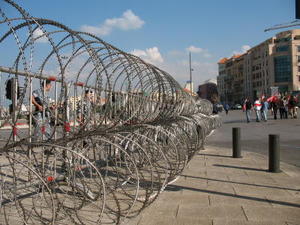My view // by Kent OlmsteadBorder security: Razor wire is a game changer
There is one solution to securing the U.S. borders that should receive more attention: razor wire; it creates a significantly more serious obstacle to every class of fence climber; the one stretch of border fence that does have razor wire (San Ysidro, five miles of it) saw significant drops in all three areas studied — attacks on border agents, illegal crossings, and injuries to illegal immigrants; razor-wire fencing can only be crossed at either end, or at any point that an investment has been made in making a breach (path through the razor wire, hole through the fence, or tunnel under the fence); this means that a stretch of razor-wire fence is reduced to known breaches — making those breaches an enforcement funnel

Razor wire deployed as an instant barrier // Source: michaeltotten.com
I read with interest the Ben Frankel border protection article. I would suggest an additional way to look at the spending on physical (and virtual) fencing along the border — as a way to communicate the level of government competence (currently, not high) regarding border security, and tangentially, immigration reform. There will be no immigration reform until there is significantly improved border security — or some perception of significantly improved border security. Even formerly pro-reform Republicans like Senator John McCain (R-Arizona) and Representative Jeff Flake (R-Arizona) have hardened their stance on security first. DHS must realize that all border spending is PR spending – either good or bad.
The SBInet virtual fence can be counted as bad PR spending — $3.7 billion to trumpet governmental incompetence. And anyone who attended Boeing’s dog-and-pony show at the beginning of SBInet (I attended in Long Beach) could see it coming from the beginning. The physical infrastructure however, most of which does improve security to some degree, also has an element of bad PR — the 12-foot ladder argument (“For every 10-foot fence there’s a 12-foot ladder”) and girls climbing the fence in under twenty seconds (PLUS countless photos of immigrants lined up and crossing the fence in various ways) — make every dollar spent an additional investment in bad PR to the pro-border security lobby.
There is a fencing component that has seen almost zero deployment on the border, which would be less-Swiftian than land mines, yet incredibly cost effective both for security and PR. The component is razor wire. As we like to say, a fence without razor wire is just a climbing wall — or something to prop your ladder against.
Razor wire is a game changer. While not indestructible, it does create a significantly more serious obstacle to every class of fence climber (see photo). The one stretch of border fence that does have razor wire (San Ysidro, five miles of it) saw significant drops in all three areas studied pre- and post-installation — attacks on border agents, crossings, and most-interesting, injuries to illegal immigrants. The drops were over 50 percent in each category. Apparently, a lot of people who climb the tallest fences get hurt jumping down the other side. With razor wire they just don’t climb it.
The DHS representative from the Information and Communication Division who relayed these results to us, said the report is private, and not likely
